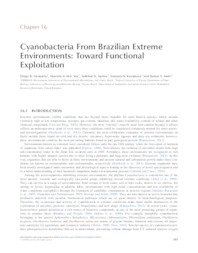Cyanobacteria from Brazilian extreme environments: toward functional exploitation.
Cyanobacteria from Brazilian extreme environments: toward functional exploitation.
Author(s): GENUÁRIO, D. B.; VAZ, M. G. M. V.; SANTOS, S. N.; KAVAMURA, V. N.; MELO, I. S. de
Summary: Extreme environments exhibit conditions that are beyond those bearable for most known species, which include extremely high or low temperature, pressure, gas content, radiation, pH, water availability, content of solutes and other chemical compounds (Van den Burg, 2003). However, the term ?extreme? must be used with caution because it always reflects an anthropocentric point of view since these conditions could be considered completely normal for some macro and microorganisms (Horikoshi et al., 2011). Currently, the most emblematic examples of extreme environments on Earth include those found on cold and dry deserts, volcanoes, hypersaline lagoons and deep sea sediments; however, these environments could be the most prevailing habitats found in past geological periods (Rampelotto, 2013). Environments known as extremes were considered lifeless until the late 19th century, when the first report of isolation of organisms from salted fishes was published (Farlow, 1880). Nevertheless, the isolation of microbial strains from high salt-concentrated water in the Dead Sea occurred only in 1936. Nowadays, these environments are recognized as rich habitats with highly adapted species due to their living constraints and long-term evolution (Rampelotto, 2013). In this way, organisms that are able to thrive in these environments and present optimal and suboptimal growth under these conditions are known as extremophiles and extremotrophs, respectively (Horikoshi et al., 2011). Extreme organisms have been mostly investigated under taxonomic and physiological aspects leading to the discovery of novel species/genera and to a better understanding of their metabolic adaptation under environmental pressure (Garland and Carter, 1994). Among the microorganisms inhabiting extreme environments, the phylum Cyanobacteria is considered one of the most ancient, versatile and ecologically successful group, inhabiting several extreme conditions (Abed et al., 2009). They can survive in a range of environments: from oceans to fresh water, soil to bare rocks, deserts to ice shelves, hot springs to Arctic, hypersaline to alkaline lakes, environments with high metal concentrations and low availability of water conditions (xerophilic) through the formation of endolithic communities in desertic regions (Sánchez-Baracaldo et al., 2005; Thajuddin and Subramanian, 2005; Rostagi and Sinha, 2009). They are also known as active biomolecules producers endowed with peculiar biochemical pathways which are of great interest in biotechnological purposes. Therefore, the occurrence and activity of cyanobacteria at extreme conditions make them useful alternatives to the exploration of enzymes, proteins, osmolytes, biopolymers and new drugs (Rampelotto, 2013). In recent years, cyanobacteria have gained attention as a rich source of bioactive compounds, as one of the most promising groups of organisms to produce them (Bhadury and Wright, 2004; Dahms et al., 2006). For example, halophilic cyanobacteria belonging to the species Aphanothece halophytica, Microcoleus chthonoplastes, Phormidium ambiguum, Oscillatoria neglecta, Oscillatoria limnetica and Oscillatoria salina are source of glycine betaine, trehalose and ectoine, all important osmolytes for agriculture and cosmetics industry (Welsh, 2000; Oren, 2010). Several species of cyanobacteria produce photoprotective metabolites that act as antioxidants, preventing cellular damage from UV-induced reactive oxygen species, and may be used in the development of artificial human sunscreen, such as scytonemin from Stigonema sp. (an extremophilic marine cyanobacterium) and mycosporine-like amino acids from endolithic cyanobacteria (V?´tek et al., 2014; Singh et al., 2017). The desiccation-resistant genus Chroococcidiopsis also exhibits resistance against ionizing radiation probably due to an efficient DNA repair mechanism (Billi, 2009). In addition, cyanobacteria have a relevant potential in producing compounds with medical applications, such as curacin A, produced by Lyngbya majuscula and dolastatin 10 which have undergone clinical trials as potential anticancer drugs (antimitotic) (Raja et al., 2014). Calothrixins A and B from Calothrix sp. inhibited the growth of the malarial parasite (Xu et al., 2016), whereas the anti-HIV and herpes simplex virus (HSV) compounds extracted from Microcystis strains may be important drug candidates for use in humans (Dixit and Suseela, 2013). In the context of extremophilic microorganisms, the number of studies is still low when compared to the great biological diversity harbored by an environment and they are mostly focused on biotechnological and industrial applications (Rampelotto, 2013). However, this is not a result of low biodiversity of extremophiles or rare extreme environments. We can attribute these problems to several factors such as (1) little knowledge on the location of extreme environments, (2) difficulties in accessing these environments and collecting samples and (3)
Publication year: 2018
Types of publication: Book sections
Unit: Embrapa Environment
Keywords: Bactéria, Cyanobacteria
Observation
Some of Embrapa's publications are published as ePub files. To read them, use or download one of the following free software options to your computer or mobile device. Android: Google Play Books; IOS: iBooks; Windows and Linux: Calibre.
Access other publications
Access the Agricultural Research Database (BDPA) to consult Embrapa's full library collection and records.
Visit Embrapa Bookstore to purchase books and other publications sold by Embrapa.

